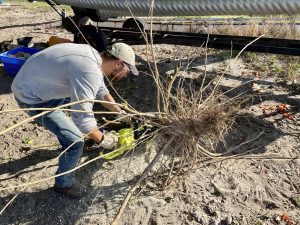FORT PIERCE, Fla.— Lukas Hallman is about to embark on an internship to investigate the vascular system of trees when they are affected by the world’s most severe citrus disease.
Lukas Hallman pursues a Ph.D. in Horticultural Sciences at the UF/IFAS IRREC
Hallman begins his final year of a Ph.D. program in horticultural sciences under the guidance of Lorenzo Rossi, assistant professor of plant root biology at the UF/IFAS Indian River Research and Education Center (IRREC) in Fort Pierce.

Probably the first study to examine grapefruit tree rings infected with citrus greening
“My goal is to measure tree ring width and detect shifts in wood anatomy within orange and grapefruit trees grown under the challenges of citrus greening,” said Hallman.
Citrus greening is present in most of Florida’s citrus groves and has reduced the state’s signature crop by 80% over the last 20 years, Rossi said.
“I will be working with trunk sections taken from 10-year-old trees. These observations will help us reconstruct how citrus trees coped with citrus greening from the day of planting to now,” said Hallman.
Components of a citrus tree’s vascular system
Hallman will investigate both components of the tree’s vascular system, called xylem and phloem, for two months at the Swiss Federal Research Institute WSL in Zurich, Switzerland. During this time, Hallman will collaborate with Professor Paolo Cherubini, a senior scientist specializing in dendrosciences, the scientific study of tree rings. Cherubini is a renowned scientist and a recipient of the 2007 Nobel Peace Prize for his role as an invited expert reviewer contributing to the Intergovernmental Panel on Climate Change Fourth Assessment Report.

International research collaboration
“International collaboration is one way scientists can address tree stress physiology under different ecosystems,” said Rossi, who once worked alongside Cherubini to investigate wood anatomical adjustments of olive trees subjected to various water availability levels.

Research proposal
“Our proposal for Hallman’s study aims to unveil changes in wood structure as a part of the citrus tree’s response to citrus greening. Clogged citrus tree vascular systems prevent the trees from absorbing the necessary nutrients for the citrus trees to grow and produce high-quality fruit,” said Rossi.
Trees from a famous grapefruit production region
The IRREC is central to the world’s famous grapefruit production region. Since shortly after the start of the 21st century, the region has seen a steep decline in its prized grapefruit crop as citrus greening spread rapidly throughout the state.
Hallman said the phloem is the specific sieve inside citrus trees that clogs with a callous material in response to infection by the bacterium that causes citrus greening disease. In his research, Hallman plans to investigate and understand phloem and xylem anatomy and tree ring formation to measure citrus physiological responses to stress. The scientists will conduct the work on grapefruit and sweet oranges grown in the Indian River Citrus District over the past 10 years.
A close look at the wood formation under citrus greening disease
“We need more information about the influence of the bacterium on phloem structure and tree and root physiology,” Hallman said. “My work has been mostly with nutrient application methods to improve the root health of affected trees. I will access highly specialized equipment in Zurich at Cherubini’s laboratory and explore vascular systems in trunks and roots of citrus greening-affected grapefruit and sweet orange trees.”

Dendrochronological study
Hallman said he and Cherubini will reconstruct the physiological history of the trees in response to citrus greening through dendrochronological and wood anatomical techniques. In addition, the researchers will measure how the trees use carbon and oxygen in response to citrus greening over the years, said Rossi.
Seeking to identify water and nutrient application methods for citrus crop trees
“Understanding linkages between phloem alterations and their relationship to carbon and oxygen utilization will allow us to identify the best water and nutrient application methods and provide more insight about how citrus trees are affected by citrus greening to advance better management of the disease,” Hallman said.
 7
7
